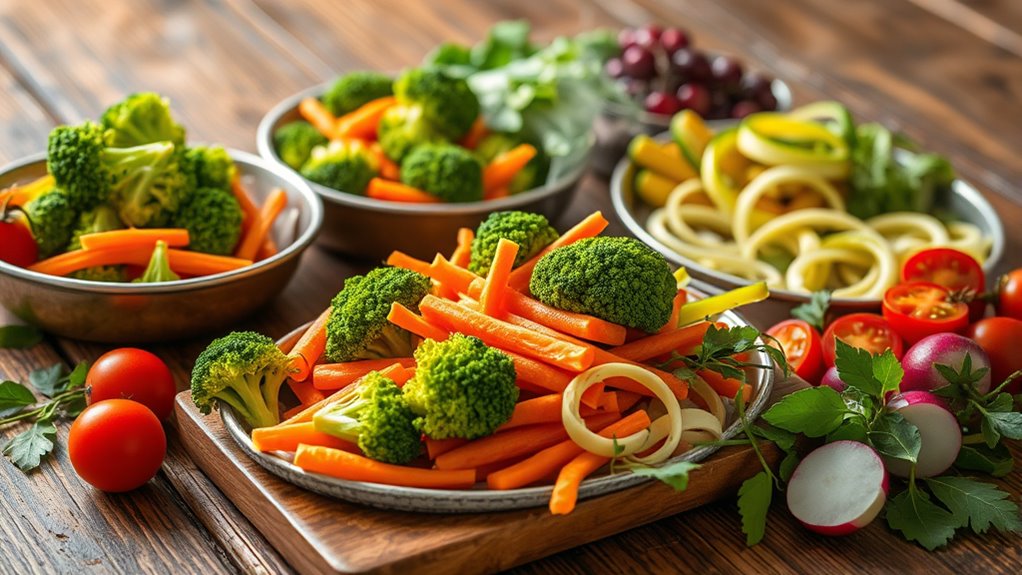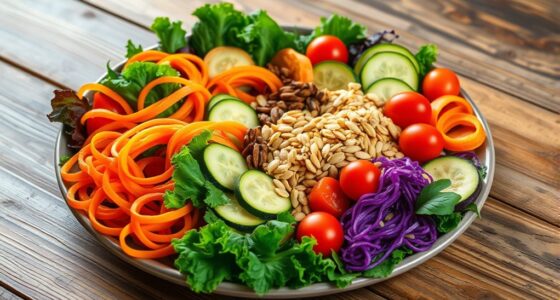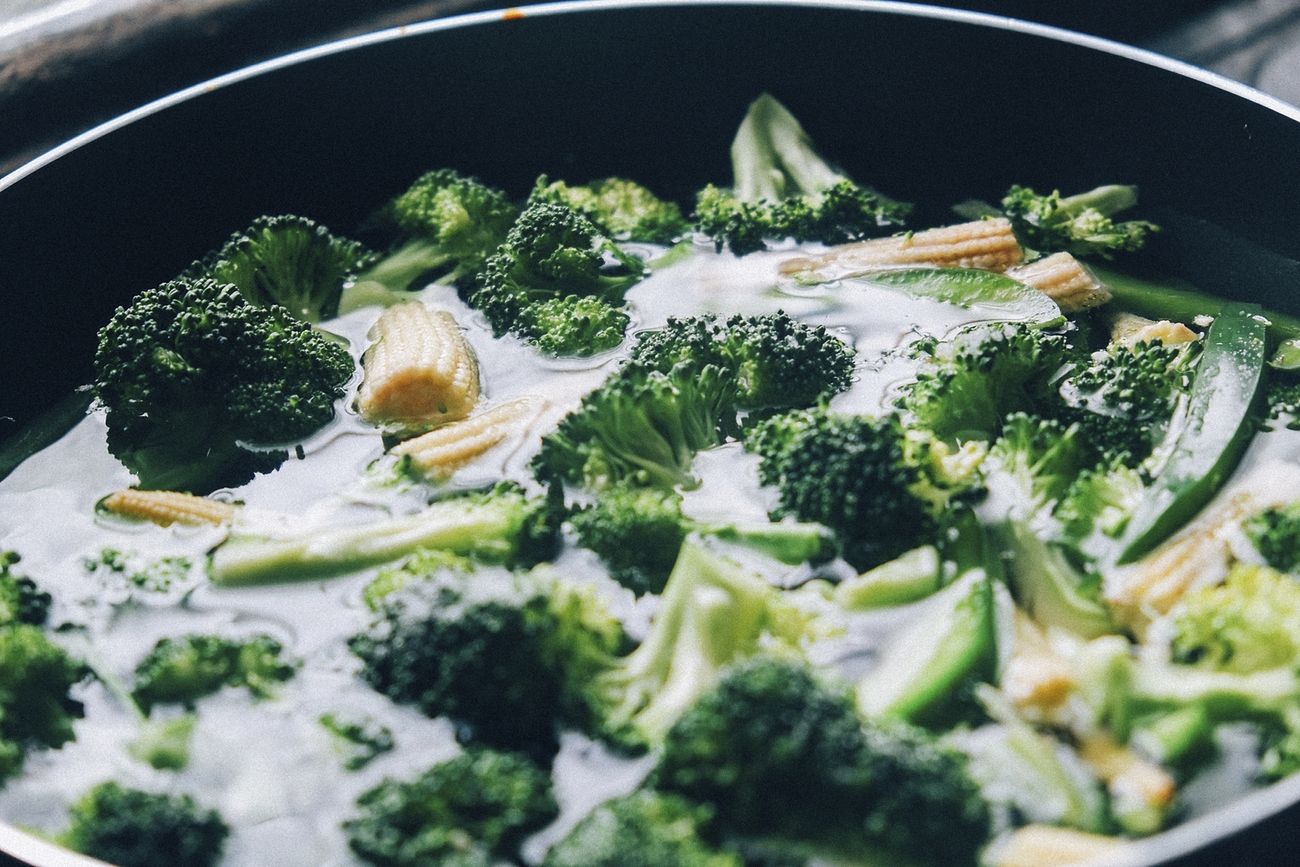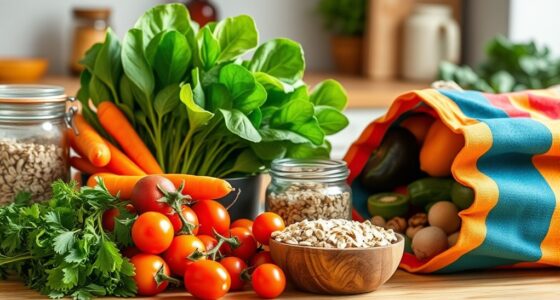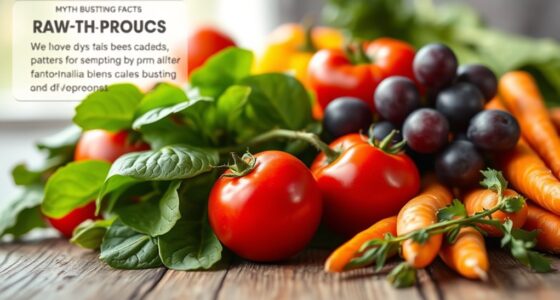To integrate lightly steamed foods into your mostly raw lifestyle, start by steaming vegetables like broccoli, carrots, or greens briefly to retain nutrients and enhance flavor. Mix steamed ingredients with raw produce in salads or bowls for variety and easier digestion. Use herbs and citrus for flavor boosts, and gradually include steamed grains or legumes to diversify your meals. Continuing with these tips will help you enjoy a nutritious, balanced approach that preserves your raw food principles while adding gentle cooked options.
Key Takeaways
- Incorporate lightly steamed vegetables like broccoli and carrots into salads for added texture and nutrient variety.
- Use steaming to soften tough raw vegetables and grains, making them easier to digest within a raw-focused diet.
- Combine raw ingredients with lightly steamed foods in bowls or wraps to enhance flavor and nutritional diversity.
- Gradually introduce lightly steamed greens and proteins to transition smoothly without compromising raw diet principles.
- Enhance steamed dishes with fresh herbs and citrus for flavor, making them more appealing and fitting into a mostly raw meal plan.
Understanding the Benefits of Light Steaming

Light steaming preserves most of the nutrients and natural flavors in foods, making it a healthier cooking method. This technique helps retain fiber content, which supports digestion and promotes a feeling of fullness. Additionally, steaming helps preserve antioxidant levels, which can boost your immune system and reduce inflammation. Unlike boiling, steaming minimizes nutrient loss, so you get more benefits from each bite. It also keeps vegetables vibrant and crisp, enhancing your overall eating experience. By maintaining these nutrients, light steaming encourages you to consume more nutrient-dense foods without sacrificing flavor or texture. Vetted methods like steaming also help reduce the formation of harmful compounds that can occur with high-heat cooking techniques. Moreover, using appropriate steaming equipment ensures even heat distribution and preserves the integrity of delicate foods. Incorporating steaming into your routine can also support a balanced diet by making healthy foods more appealing and easier to prepare. Research shows that steaming can also help preserve vitamin content, making it easier to meet daily nutritional requirements. Whether you’re aiming for better digestion or increased antioxidant intake, steaming offers a simple, effective way to enjoy wholesome, nutritious meals while supporting your health goals.
Choosing the Right Vegetables for Light Steaming
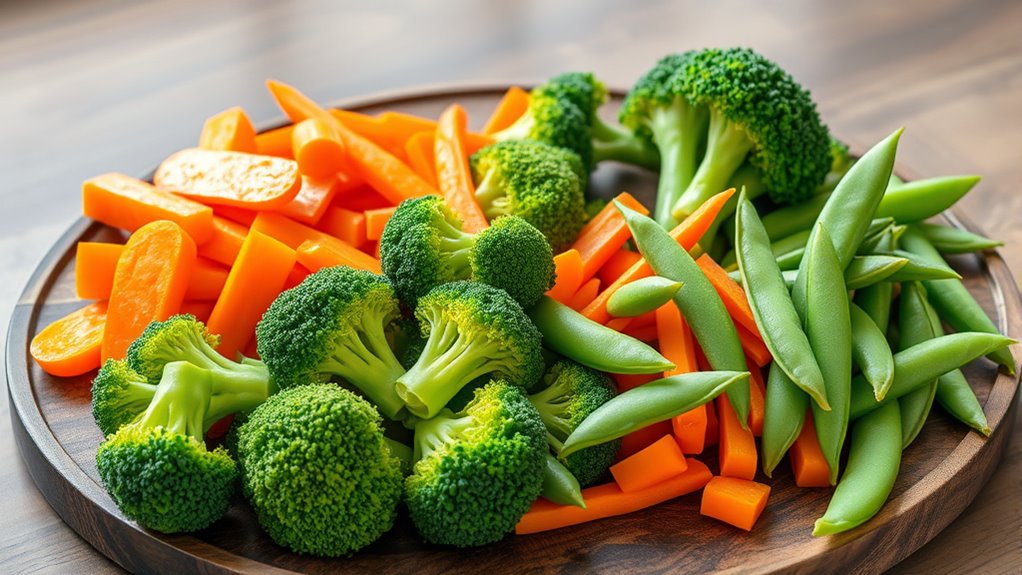
Choosing the right vegetables for light steaming helps maximize nutrient preservation while maintaining flavor. Focus on options like broccoli, carrots, and green beans, which steam quickly and retain their vitamins. Remember to adjust steaming times to avoid overcooking and nutrient loss. Using the right brewing methods can also impact the retention of nutrients in your vegetables. Additionally, adopting techniques such as gentle steaming can further help preserve sensitive nutrients during preparation. Proper temperature control during steaming is essential to prevent nutrient degradation and ensure optimal flavor. Incorporating vintage or distressed furniture, for example, can create a cozy, authentic farmhouse atmosphere that complements your healthy lifestyle.
Nutrient Preservation Tips
To maximize nutrient retention during light steaming, selecting the right vegetables is essential. Fresh, vibrant produce retains more vitamins and minerals, so choose vegetables at their peak ripeness. Proper equipment maintenance ensures even steaming and food safety, preventing bacterial growth. To preserve nutrients, avoid overcooking, which can cause nutrient loss. Here are some tips to help you keep nutrients intact:
- Opt for vegetables with high water content, like broccoli, spinach, and zucchini.
- Use a steamer basket that fits your pot snugly to prevent nutrient leakage.
- Keep steaming times short—about 3-5 minutes—to preserve vitamins.
- Cover vegetables during steaming to lock in nutrients.
- Immediately cool vegetables after steaming to halt nutrient degradation.
Best Vegetable Choices
Selecting the right vegetables for light steaming can substantially boost your nutrient intake and enhance your meals. Focus on vegetables that retain their flavor and texture when lightly cooked, such as broccoli, carrots, zucchini, and snap peas. When vegetable harvesting, choose fresh, seasonal produce for ideal flavor and nutrients. Seasonal vegetables are often fresher, more affordable, and more sustainable, making them perfect for steaming. Root vegetables like beets and sweet potatoes also work well, providing natural sweetness and nutrients with minimal cooking time. Leafy greens like spinach and kale can be lightly steamed to preserve their delicate textures and essential vitamins. Incorporating seasonal produce can further maximize the nutritional benefits of your steamed dishes. By selecting seasonal produce and high-quality vegetables, you guarantee your steamed dishes are both nutritious and delicious.
Steaming Duration Tips
Knowing the ideal steaming times for different vegetables guarantees your dishes turn out perfectly every time. To achieve the perfect vegetable softness, pay attention to steaming duration. For crisper vegetables, steam for shorter periods; for softer textures, extend the steaming time. Here are some tips to help you choose the right vegetables for light steaming:
- Select vegetables with similar thicknesses for even cooking
- Prioritize bite-sized pieces to reduce steaming time
- Use a steaming basket to prevent overexposure
- Test vegetable softness with a fork during steaming
- Adjust steaming duration based on desired vegetable tenderness
Techniques for Perfectly Lightly Steamed Foods
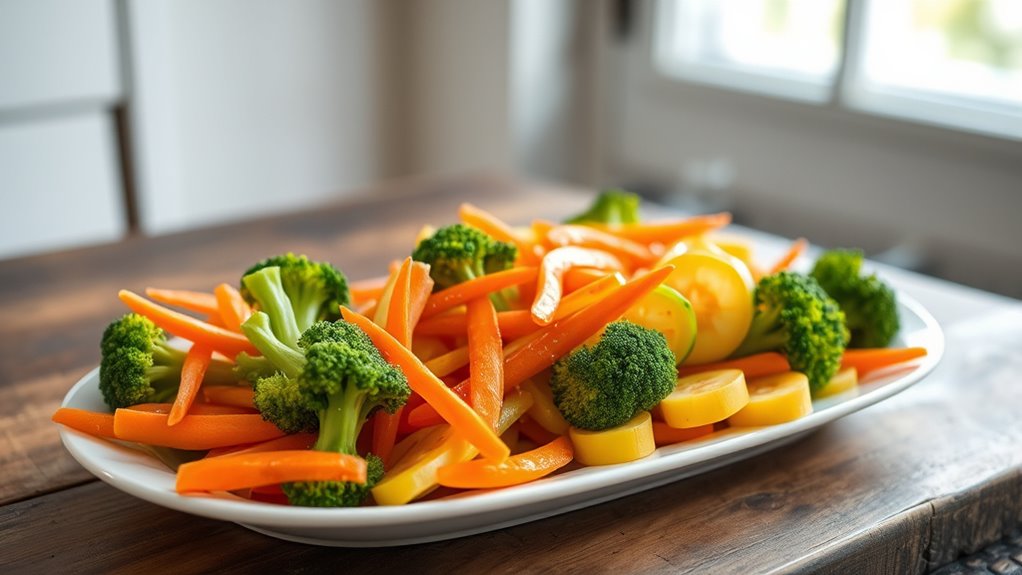
Mastering the art of lightly steaming foods involves paying close attention to timing and temperature. Use the right steaming equipment, such as a bamboo steamer or metal basket, to ensure even heat distribution. Keep the water at a gentle simmer—not boiling vigorously—to prevent overcooking. To enhance flavor infusions, add herbs, garlic, or spices directly to the steaming water or place them on the food, allowing subtle taste enhancements. Cover the steamer securely to trap steam and maintain consistent heat. Checking the food frequently helps prevent over-steaming, which can cause loss of texture and nutrients. With practice, you’ll develop a feel for perfect timing and temperature, resulting in delicately cooked, flavorful foods that retain their nutrients and vibrant appearance. Incorporating automation technologies into your steaming process can help monitor and control temperature more precisely. Additionally, selecting appropriate steaming techniques can optimize nutrient preservation and flavor, especially when aiming to retain the maximum nutritional value in lightly steamed foods. Understanding the importance of temperature control can further enhance your results and ensure optimal nutrient retention.
Incorporating Lightly Steamed Dishes Into Raw Meal Plans
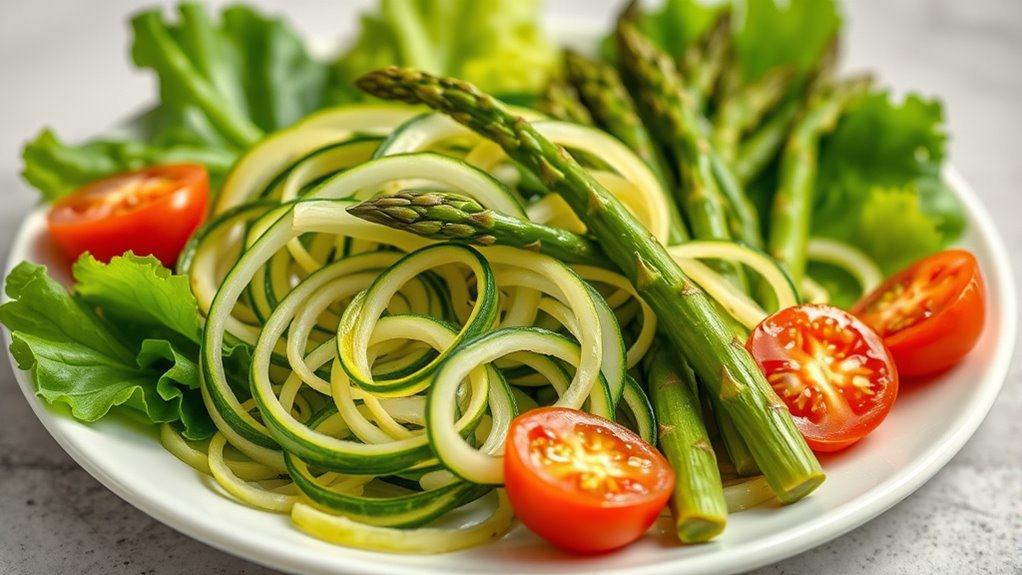
Incorporating lightly steamed dishes into your raw meal plan can add variety and warmth without compromising the overall raw food philosophy. Many believe raw food myths that exclude all cooked elements, but light steaming can be a beneficial *gradual shift*. To do this effectively, invest in good steaming equipment that preserves nutrients and textures. Here are some tips to integrate steamed foods seamlessly:
- Use steaming to soften tough vegetables for easier digestion
- Combine raw and lightly steamed ingredients in salads
- Incorporate steamed grains or legumes for added protein
- Experiment with steaming times to retain maximum nutrients
- Avoid overcooking to prevent nutrient loss and preserve flavor
Flavor Enhancements for Steamed Foods

To elevate your steamed dishes, consider pairing them with fresh herbs like basil or cilantro for vibrant flavor. You can also add savory sauces or drizzles, such as tahini or soy-based options, to enhance richness. Bright citrus, like a squeeze of lemon or lime, can finish your meal with a zesty, invigorating touch. Incorporating flavor pairing techniques can further enhance the overall taste experience. Additionally, exploring trends in wealth transformation can inspire creative and luxurious food presentations that reflect your personal style. Incorporating proper food safety practices when handling ingredients ensures your meals remain healthy and delicious.
Engaging your senses through emotional expression can deepen your appreciation and enjoyment of the flavors.
Fresh Herb Pairings
Fresh herbs can transform the flavor profile of lightly steamed foods, adding brightness and depth without overpowering their natural taste. Choosing herbs with complementary herb flavor profiles enhances your dishes and keeps the natural essence intact. To maximize flavor, use fresh herb preservation techniques like chopping just before serving or freezing herbs in ice cubes. Popular options include:
- Basil for sweet, aromatic notes
- Cilantro with citrusy brightness
- Mint for cooling freshness
- Dill with subtle, grassy undertones
- Parsley for a clean, mild flavor
These herbs elevate steamed vegetables and proteins, creating a vibrant, fresh taste. By selecting herbs wisely and preserving them properly, you ensure consistent flavor and enjoy the benefits of fresh herb pairings in your mostly raw lifestyle. Additionally, incorporating herb storage methods can help maintain their freshness and flavor over time, supported by research on personality traits that influence how we approach food preparation and preservation. Incorporating proper herb drying techniques can also extend their usability and flavor retention.
Savory Sauces and Drizzles
Adding savory sauces and drizzles can elevate lightly steamed foods by enhancing their natural flavors and adding depth to every bite. When choosing sauces for steaming, opt for rich, umami-packed options like soy-based or miso-based sauces that complement the delicate textures. Drizzling techniques are key; you can drizzle thin streams of sauce across vegetables, fish, or grains to add flavor without overwhelming the dish. Use a spoon or squeeze bottle for precision, ensuring even coverage. Warm the sauces slightly to release their aroma and make application smoother. These techniques allow you to customize each dish, balancing flavors and textures. By thoughtfully incorporating sauces for steaming and mastering drizzling techniques, you add complexity and satisfaction to your lightly steamed meals.
Bright Citrus Additions
Bright citrus flavors can transform plain steamed foods into vibrant, palate-pleasing dishes. Adding citrus zest or fruit infusions elevates simple greens or vegetables with fresh, tangy notes. You can sprinkle grated citrus zest directly onto steamed dishes for an aromatic boost. Alternatively, infuse oils or dressings with lemon, lime, or orange to create bright flavor profiles. Consider these ideas:
- Garnish with lemon or lime zest before serving
- Drizzle citrus-infused olive oil over greens
- Mix fruit infusions into dipping sauces
- Add orange or grapefruit segments for visual appeal
- Use citrus juice to brighten steamed vegetable flavors
These techniques make your lightly steamed foods more dynamic without overwhelming their natural qualities, keeping your mostly raw lifestyle fresh and exciting.
Tips for Transitioning to a Mostly Raw Lifestyle With Light Cooking
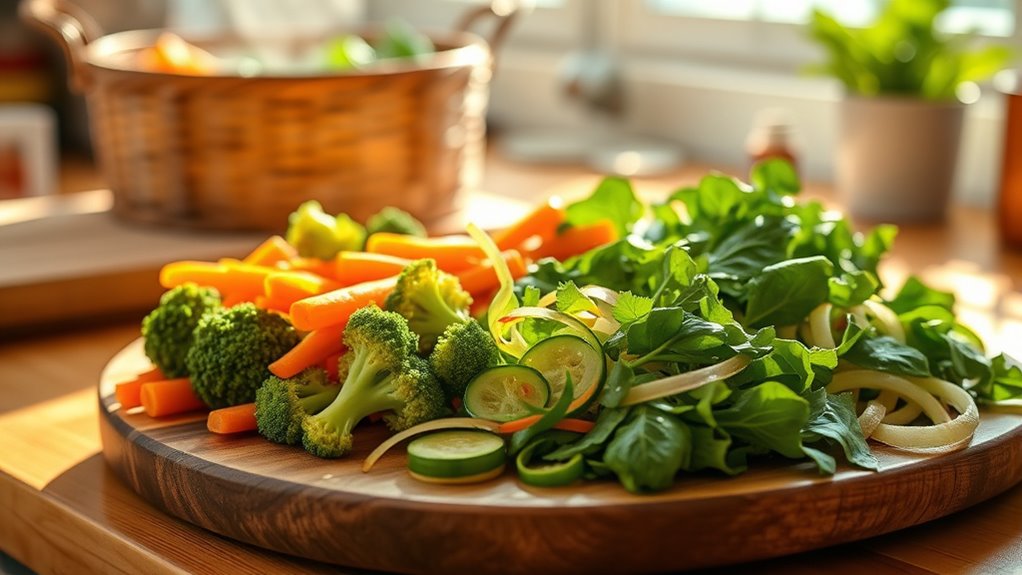
Shifting to a mostly raw lifestyle with light cooking can be smooth if you start gradually and listen to your body. Many believe raw food myths that suggest you must eat everything completely uncooked, but light steaming or minimal cooking can help with digestion and variety. Focus on simple kitchen equipment like a steamer basket or gentle heat source to preserve nutrients while softening foods. Progressing gradually allows your digestive system to adjust and helps you discover which textures and flavors you prefer. Keep experimenting with different vegetables, fruits, and light-cooked grains to find what works best. Remember, the goal isn’t perfection but creating a sustainable, enjoyable balance that enhances your health and satisfies your tastes.
Creative Recipes Combining Raw and Lightly Steamed Ingredients
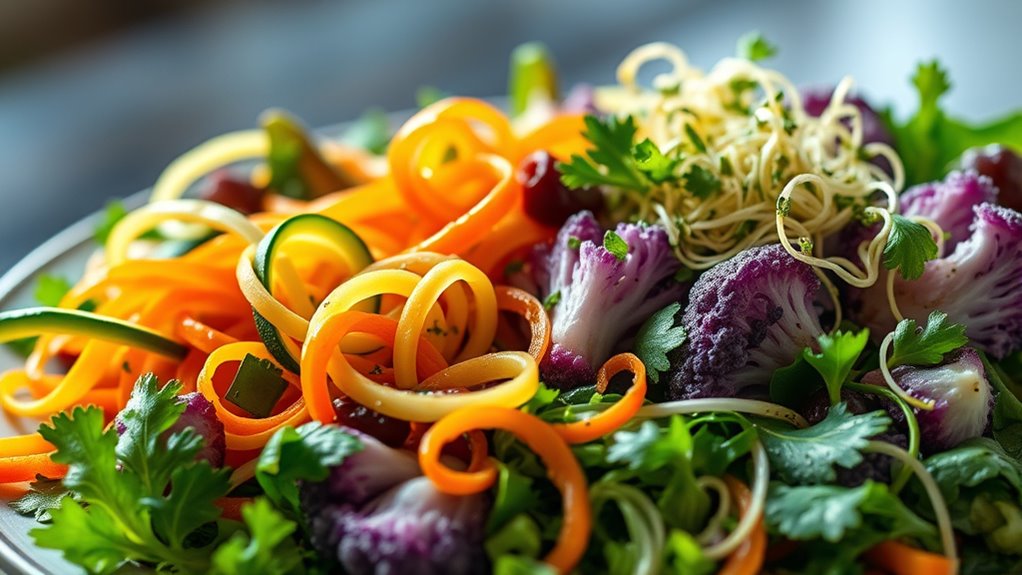
Creating delicious recipes that blend raw and lightly steamed ingredients opens up a world of flavor and texture. You can honor cultural food traditions while accommodating dietary restrictions, making meals more satisfying and diverse. Think outside the box by combining crisp vegetables with warm, tender grains or proteins.
- Use raw vegetables as toppings on lightly steamed fish or chicken
- Create sushi bowls with raw avocado, cucumber, and lightly steamed rice
- Mix raw herbs with steamed vegetables for fresh salads
- Incorporate lightly steamed greens into raw wraps or sushi
- Blend raw fruits with lightly steamed nuts for vibrant desserts
These approaches not only enhance flavor but also respect traditional methods, offering a balanced way to enjoy both raw and steamed foods within your lifestyle.
Frequently Asked Questions
How Can I Ensure Variety in My Lightly Steamed Meals?
To guarantee variety in your lightly steamed meals, focus on using seasonal produce to keep flavors fresh and exciting. Experiment with different vegetables and herbs to create unique flavor combinations that surprise your palate. Mix textures by combining steamed items with raw elements, and rotate ingredients regularly. This approach not only keeps your meals interesting but also provides a diverse array of nutrients, making your mostly raw lifestyle more enjoyable and sustainable.
Are There Specific Tools Recommended for Light Steaming?
Think of your tools as your culinary allies. For light steaming, you’ll want reliable steaming equipment like a bamboo steamer, metal basket, or electric steamer. These tools make food preparation techniques easier and more efficient, ensuring your veggies stay vibrant and nutritious. Choose equipment that fits your kitchen space and lifestyle, so you can effortlessly incorporate lightly steamed foods into your meals, enhancing variety without sacrificing convenience.
How Do I Store Lightly Steamed Foods Safely?
To store lightly steamed foods safely, you should focus on proper refrigeration techniques and use suitable storage container options. First, let the food cool slightly at room temperature, but don’t leave it out for more than two hours. Then, transfer it to airtight containers, like glass or BPA-free plastic, to prevent moisture loss and contamination. Store in the refrigerator at or below 40°F and consume within 2-3 days for maximum freshness.
Can I Incorporate Light Steaming Into a Vegan Diet?
Yes, you can definitely incorporate light steaming into your vegan diet. Steaming helps preserve plant-based nutrients and makes vegan proteins like tofu, tempeh, or vegetables easier to digest. It’s a great way to reveal more flavor and improve texture while maintaining the integrity of your plant-based nutrients. Plus, it adds variety to your meals without sacrificing the raw aspect, making your vegan lifestyle more enjoyable and balanced.
What Are Common Mistakes to Avoid When Light Steaming?
You might find yourself overcooking vegetables or using excessive water when steaming, which can sap nutrients and flavor. To avoid these mistakes, keep an eye on the steaming time and use just enough water to create gentle steam. A coincidence? It’s easy to forget that less is more—less water, less overcooking—preserving the vibrant colors, textures, and nutrients you want from light steaming.
Conclusion
By incorporating lightly steamed foods into your mostly raw lifestyle, you can enjoy the best of both worlds—nutrient retention and improved digestion. Did you know that steaming vegetables can boost antioxidant levels by up to 30%? As you experiment with gentle cooking methods, you’ll find it easier to stick to your health goals while savoring delicious, vibrant meals. Embrace this balanced approach and watch your energy and well-being flourish.
Aurelia is the Editor-in-Chief of The Graceful Kitchen, a vegan lifestyle blog that focuses on delicious, nutritious, and ethical eating. A lifelong vegan, Aurelia is passionate about sharing her love of plant-based cuisine with others. She is a regular contributor to several online and print publications, and has been interviewed by major news outlets about the benefits of a vegan diet. In her free time, Aurelia enjoys cooking, hiking, and spending time with her cats.
